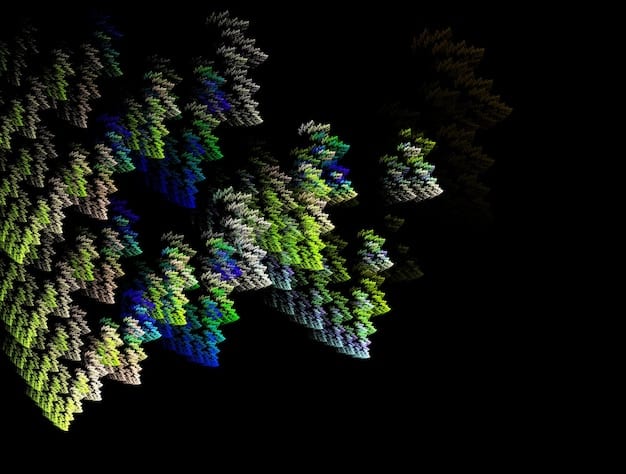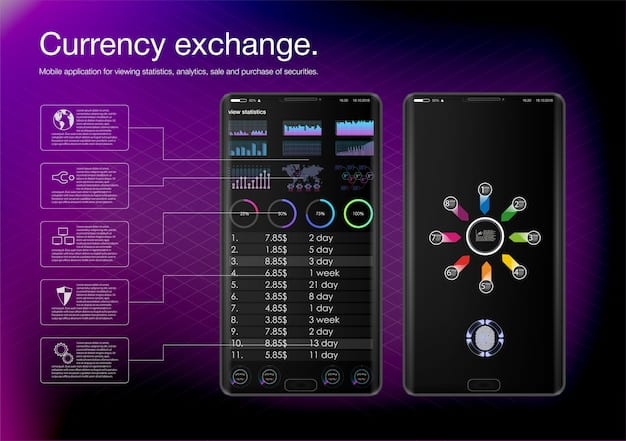Unlocking Solana DeFi Composability: Maximize Profits with Advanced Strategies

Understanding Solana DeFi Composability: Building Complex Strategies for Maximum Profit involves leveraging the interoperability of DeFi protocols on the Solana blockchain to create sophisticated financial strategies that can amplify returns while managing risks.
Solana, a high-throughput blockchain, has become a fertile ground for decentralized finance (DeFi). Understanding Solana DeFi Composability: Building Complex Strategies for Maximum Profit is now more accessible than ever, offering avenues for sophisticated financial strategies that can significantly amplify returns.
What is Solana DeFi Composability?
Solana DeFi composability refers to the ability of different DeFi protocols on the Solana blockchain to seamlessly interact and integrate with each other. This interoperability allows developers and users to combine various financial tools and services to create complex strategies.
Composability is a cornerstone of DeFi, enabling the creation of sophisticated applications through the combination of simpler building blocks. On Solana, this concept is amplified by the network’s high speed and low transaction costs.
Benefits of Composability
Composability in Solana DeFi offers several key advantages. Let’s explore some of them:
- Increased Efficiency: By combining different protocols, users can execute complex strategies in a single transaction, reducing fees and slippage.
- Enhanced Flexibility: Composability enables the creation of highly customized financial products tailored to specific user needs and risk profiles.
- Innovation: Developers can leverage existing protocols as building blocks to create novel applications, fostering innovation within the ecosystem.
Challenges of Composability
While composability offers numerous benefits, it also presents some challenges that need to be addressed:
- Smart Contract Risk: Integrating multiple protocols increases the risk of smart contract vulnerabilities and exploits.
- Complexity: Building and understanding complex composable strategies can be challenging for both developers and users.
- Systemic Risk: The interconnected nature of composable protocols can amplify systemic risk, where failures in one protocol can cascade to others.
In conclusion, Solana DeFi composability is a powerful concept that offers increased efficiency, enhanced flexibility, and fosters innovation. However, it also presents challenges related to smart contract risk, complexity, and systemic risk that require careful consideration.
Key DeFi Protocols on Solana
Solana’s DeFi ecosystem is rich with various protocols that enable different financial services. Here’s an overview of some key protocols and their functionalities.
These protocols form the building blocks for composable DeFi strategies on Solana, offering users a wide range of financial tools.

Decentralized Exchanges (DEXs)
DEXs like Raydium and Orca allow users to trade tokens in a decentralized manner. They are foundational to DeFi as they provide liquidity and price discovery.
Raydium, for example, integrates with Serum’s central limit order book, offering users access to deep liquidity. Orca focuses on user-friendliness and simplicity, making it easier for new users to participate in DeFi.
Lending and Borrowing Platforms
Platforms like Solend and Mango Markets enable users to lend and borrow assets, creating opportunities for leveraged trading and yield farming.
- Solend: Offers isolated lending pools, allowing users to lend and borrow specific assets without risking their entire portfolio.
- Mango Markets: Combines spot trading, margin trading, and perpetual futures in a single platform.
Yield Aggregators
Yield aggregators like Tulip Protocol automate yield farming strategies, optimizing returns for users by automatically allocating funds to the highest-yielding opportunities.
- Automated Rebalancing: These platforms automatically rebalance portfolios to maximize returns.
- Risk Management: Some yield aggregators also incorporate risk management features to protect user funds.
In short, the Solana DeFi ecosystem includes decentralized exchanges (DEXs) like Raydium and Orca for token trading, lending and borrowing platforms such as Solend and Mango Markets for leverage and yield, and yield aggregators like Tulip Protocol that automate and optimize yield farming strategies, each contributing to the composable nature of Solana DeFi.
Building Blocks of Complex DeFi Strategies
Understanding the fundamental building blocks is crucial before diving into complex DeFi strategies. These components include trading, lending, borrowing, and yield farming.
By combining these building blocks, users can create highly customized and sophisticated financial strategies to achieve their specific goals.
Trading
Trading involves exchanging one asset for another on a DEX. This is a fundamental activity in DeFi and forms the basis for many other strategies.
Traders can use DEXs to speculate on price movements, arbitrage between different markets, or simply acquire the tokens they need to participate in other DeFi activities.
Lending and Borrowing
Lending involves providing assets to a lending platform in exchange for interest, while borrowing involves taking out a loan using assets as collateral.
These activities allow users to earn passive income on their holdings or gain access to capital for other purposes, such as leveraged trading or yield farming.
Yield Farming
Yield farming involves providing liquidity to a DEX or participating in other DeFi protocols to earn rewards in the form of additional tokens.
- Liquidity Mining: Users earn rewards by providing liquidity to a DEX.
- Staking: Users earn rewards by staking tokens in a specific protocol.
Leveraged Positions
Combining lending, borrowing, and trading allows for the creation of leveraged positions, amplifying both potential gains and losses.
- Margin Trading: Borrowing funds to increase the size of a trade.
- Perpetual Futures: Trading contracts that have no expiration date, allowing users to maintain leveraged positions indefinitely.
In summary, trading, lending, and borrowing serve as crucial components in Solana DeFi, facilitating activities from simple token exchanges to complex leveraged positions.
Advanced DeFi Strategies on Solana
Once you have a grasp of the foundational building blocks, you can explore more advanced strategies. These strategies often involve combining multiple protocols to achieve specific financial objectives.
These advanced strategies can be highly profitable but also come with increased risks. It’s important to understand the underlying mechanisms and potential pitfalls before deploying capital.

Leveraged Yield Farming
Leveraged yield farming involves borrowing assets to increase the size of a yield farming position, thereby amplifying potential returns.
For example, a user could borrow SOL against their existing SOL holdings and then use the borrowed SOL to provide liquidity to a Raydium pool, earning a higher yield than they would have with their initial holdings alone.
Cross-Protocol Arbitrage
Cross-protocol arbitrage involves taking advantage of price discrepancies for the same asset across different DeFi protocols.
- DEX Arbitrage: Buying an asset on one DEX where it is cheaper and selling it on another DEX where it is more expensive.
- Lending Arbitrage: Borrowing an asset on one platform at a lower interest rate and lending it on another platform at a higher interest rate.
Delta-Neutral Strategies
Delta-neutral strategies aim to generate profits regardless of the direction of the market. These strategies typically involve offsetting long and short positions in correlated assets.
- Basis Trading: Taking opposite positions in the spot market and futures market.
- Staking Derivatives: Using derivatives to hedge against price movements of underlying assets while earning staking rewards.
In brief, advanced DeFi strategies on Solana include leveraged yield farming to amplify returns, cross-protocol arbitrage to exploit price differences, and delta-neutral strategies to profit regardless of market direction, each requiring a deep understanding of the involved protocols and associated risks.
Risk Management in Solana DeFi
Effective risk management is crucial when participating in Solana DeFi. Given the inherent complexities and potential vulnerabilities, it’s essential to understand and mitigate various risks.
A comprehensive risk management approach involves diversifying your portfolio, conducting thorough research, and staying informed about the latest developments in the DeFi space.
Smart Contract Risk
Smart contract risk refers to the possibility of vulnerabilities or bugs in the code of DeFi protocols that could lead to loss of funds.
- Audits: Look for protocols that have undergone security audits by reputable firms.
- Code Review: Understand the code and how it works.
- Bug Bounty Programs: Participate in bug bounty programs to help identify and fix vulnerabilities.
Liquidity Risk
Liquidity risk is the risk of not being able to buy or sell an asset quickly enough to prevent a loss.
- Slippage: Be aware of slippage, which is the difference between the expected price of a trade and the actual price at which it is executed.
- Impermanent Loss: Understand impermanent loss, which can occur when providing liquidity to a DEX.
Systemic Risk
Systemic risk is the risk that a failure in one DeFi protocol could trigger a cascade of failures across the entire ecosystem.
- Diversification: Diversify your holdings across multiple protocols to reduce your exposure to any single point of failure.
- Monitoring: Stay informed about the health and stability of the protocols you are using.
In conclusion, smart contract risk, liquidity risk, and systemic risk are significant concerns in Solana DeFi that can be mitigated through audits, understanding slippage and impermanent loss, diversification, and continuous monitoring.
Future of Solana DeFi Composability
The future of Solana DeFi composability looks promising, with ongoing developments and innovations paving the way for even more sophisticated and interconnected financial strategies.
As the ecosystem matures, we can expect to see new protocols, improved infrastructure, and increased adoption, further unlocking the potential of composable DeFi on Solana.
Potential Developments
Several potential developments could shape the future of Solana DeFi composability.
- Cross-Chain Composability: Extending composability to other blockchain networks, enabling seamless interaction between DeFi protocols on different chains.
- Institutional Adoption: Increased participation from institutional investors, bringing more capital and sophistication to the DeFi space.
- Improved User Experience: Continued efforts to improve the user experience of DeFi protocols, making them more accessible to a wider audience.
Challenges Ahead
Despite the promising outlook, several challenges need to be addressed to fully realize the potential of Solana DeFi composability.
- Regulatory Uncertainty: Clarity and consistency in the regulatory landscape are needed to foster innovation and growth in the DeFi space.
- Scalability: Solana needs to continue to scale its infrastructure to accommodate increasing transaction volumes and user activity.
In short, the future of Solana DeFi composability is promising, with potential advancements in cross-chain functionality and institutional adoption, but challenges like regulatory uncertainty and scalability must be addressed as the ecosystem grows.
| Key Point | Brief Description |
|---|---|
| 🔗 Solana DeFi Composability | Interoperability of DeFi protocols on Solana for complex financial strategies. |
| 🛠️ Building Blocks | Trading, lending, borrowing, and yield farming as basic DeFi components. |
| 💼 Advanced Strategies | Leveraged yield farming, cross-protocol arbitrage, and delta-neutral setups. |
| 🛡️ Risk Management | Addressing smart contract risk, liquidity risk, and systemic risk in DeFi. |
FAQ
▼
DeFi composability refers to the ability of different DeFi protocols to interact and integrate seamlessly. It’s important because it allows for the creation of complex, innovative financial products by combining simpler building blocks, increasing efficiency and flexibility.
▼
The main risks include smart contract vulnerabilities, which become amplified with each integration, liquidity risks, and systemic risks, where the failure of one protocol can cascade to others due to their interconnected nature.
▼
Mitigation strategies include using protocols that have undergone rigorous security audits, diversifying your portfolio across multiple protocols to reduce exposure, and staying informed by regularly reviewing the protocols’ security practices and updates.
▼
Leveraged yield farming involves borrowing assets to increase the size of your yield farming position, amplifying potential returns. However, it also increases the risk of losses, especially during market volatility, and can lead to liquidation if positions are not managed carefully.
▼
To stay informed, regularly consult reputable DeFi news sources, follow key influencers and developers on social media, participate in community forums and groups, and monitor on-chain data and analytics platforms to track protocol performance and identify potential risks.
Conclusion
Understanding and leveraging Solana DeFi composability offers significant opportunities for building complex strategies and maximizing profit. However, it’s crucial to approach these strategies with a clear understanding of the associated risks and a commitment to effective risk management. By staying informed, diversifying your portfolio, and continuously monitoring the ecosystem, you can navigate the world of Solana DeFi composability with greater confidence and potentially achieve superior financial results.





